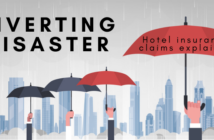A rising expense with limited control
For most U.S. hotel owners and operators, one of the major challenges in 2023 has been the need to control expenses amidst slowing revenue growth. Through September of 2023, the properties in CBRE’s monthly survey of hotel operating statements have seen their total operating revenues increase by 7.4% year-over-year, while total operating expenses1 grew by 10.0% during the same period. The net result was a decline in earnings before interest, taxes, depreciation, and amortization (EBITDA) of 0.2%.
On a percentage basis, the department with the greatest expense increase during 2023 has been insurance. Through September of 2023, insurance costs for the hotels in CBRE’s monthly survey sample have risen by 19.5% over 2022. The 11th edition of the Uniform System of Accounts for the Lodging Industry defines insurance as the cost of insuring building, contents, and liability, as well as deductible payments.
To assess trends in U.S. hotel insurance expense, we analyzed the performance of 2,565 hotels that reported insurance payments each year from 2015 through 2022 for our annual Trends® in the Hotel Industry survey. In 2022, these properties averaged 215 rooms in size, with an occupancy of 66.2% and an average daily rate of $195.87. For our 2023 estimates, we relied on data from our monthly survey of 2,550 U.S. hotels.
INSURANCE COSTS BY PROPERTY TYPE
In 2023, we estimate hotel insurance costs to be 1.7% of total operating revenue. While this makes it a relatively minor expense, the 1.7% mark is greater than the long-run average of 1.2%. As a percentage of total revenue in 2022, insurance expense was greatest at extended-stay hotels (1.9%) and lowest at convention hotels (1.1%). These ratios are more of a function of the amount of revenue, as opposed to the cost of coverage.
The disparities in the cost of coverage can be seen when analyzing 2022 insurance expense on a dollar-per-available room basis (PAR). Using this method, insurance expense is greatest at resort hotels, due to their extensive facilities and services, location in high-risk environments, and multiple recreational offerings. Resort insurance expenses averaged $2,464 PAR in 2022, well above the $939 PAR overall average for the sample. With a smaller footprint and minimal services, limited-service hotels pay the least ($528 PAR) for their insurance coverage.
FACTORS THAT INFLUENCE INSURANCE COSTS
Hotels aren’t alone suffering from significant increases in insurance costs during 2022 and 2023, as insurance costs are on the rise for all forms of commercial real estate. Some of the factors driving the surge in commercial insurance premiums include:
- The number of losses incurred by buildings and businesses are occurring at a much more frequent rate in recent history. This includes hurricanes in Florida, fires in California and Hawaii, tornadoes in the Midwest, winter freezes in Texas, and convective storms all over the United States.
- Concurrently, the cost of fixing damages and replacing buildings has gone up. Since the pandemic, supply chain interruptions and a lack of available labor has driven up the cost of construction-related goods and services. This is leading to increased building valuation and, in turn, increased premiums.
- The insurance business is global in nature and increases in covered incidences outside the U.S. influence domestic prices.
All these factors have led to increasing reinsurance costs for insurers, which directly impacts commercial pricing.
REGIONAL VARIATION
Because environmental issues have a significant impact on the cost of insurance, it isn’t surprising we see variation in the historical changes of insurance costs by geography.
From 2015 through 2022, insurance costs for the hotels in our sample increased by a compound annual growth rate (CAGR) of 6.2%. The growth was the greatest for hotels located in the Southeast (7.2%), South Central (6.7%), and Mountain/Pacific (6.2%) regions. These areas are most susceptible to hurricanes, earthquakes, and forest fires, respectively. Conversely, insurance costs grew the least for hotels in the Northeast (3.7%) and North Central (5.4%) regions.
Insurance costs also vary significantly by region. Paying the most for insurance in 2022 were hotels located in the Mountain/Pacific region ($1,220 PAR) and properties in the Southeast ($1,156 PAR). Hotels in the North Central region ($479 PAR) paid the least for insurance in 2022.
COST CONTROL
Unfortunately for U.S. hoteliers, the ability to control insurance costs is limited. On property, hotel owners can make physical “risk improvements” such as flood gates and earthquake seismic shutoff valves. Owners also have the option to buy less insurance, or increase their deductible, to reduce their premiums.
Most insurance experts believe it’s unlikely for hotel insurance costs to drop in the near term. However, given the cyclical nature of the environment and construction costs, it’s hoped the pace of insurance expense growth will slow down and revert to the long-run average.
REFERENCE
1. Expenses through EBITDA.
is Director of Research Information Services for CBRE Hotels Research. He can be reached at [email protected] or (404) 812-5187.


 Robert Mandelbaum
Robert Mandelbaum


